
All categories
Featured selections
Trade Assurance
Buyer Central
Help Center
Get the app
Become a supplier

(3935 products available)

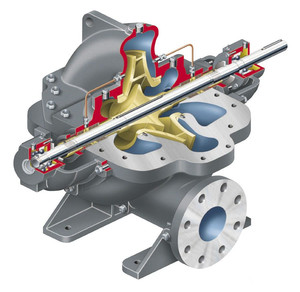


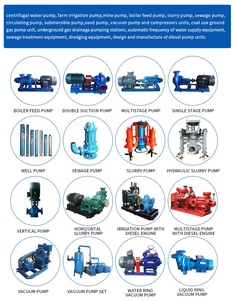












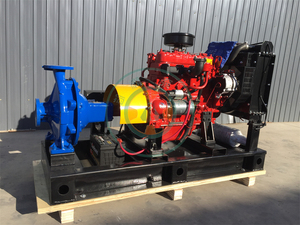

















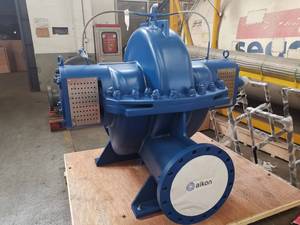



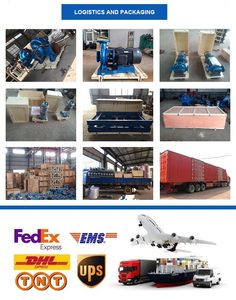






Double-suction centrifugal pumps are designed for high-capacity, high-efficiency liquid-moving tasks. They have two inlets (or "suction" sides") that let them handle large volumes of fluid with smoother flow and less turbulence than single-suction styles. Here are some common types based on function and use:
Single-stage double suction centrifugal pumps
These models have one impeller that gets the water moving. Even though it has two suction sides, everything happens in one stage, which makes it simpler and lighter. This type works well where the flow demand is not too high and where users require a pump that is easy to install and maintain.
Multi-stage double suction centrifugal pumps
These are more complex, adding multiple impellers to boost pressure as well as flow. These pumps are helpful in situations that call for long-distance pumping or where higher pressure is necessary, such as in high-rise building water supply systems.
Vertical double suction centrifugal pumps
As the name suggests, these pumps are oriented in a vertical position rather than the horizontal position commonly seen. This type of configuration can save space and is usually deployed in areas where floors are restrictive in size and space. A vertical double-suction pump is also useful in low and high rural flooding.
Slurry double suction centrifugal pumps
Pumps of this kind are specifically engineered to handle thick and rough liquids containing solids (like mud, minerals, etc.) rather than just typical clean liquids. They have stronger impellers and casings to avoid breaking down and help tackle these harsher environments. Slurry pumps are commonly found in mining, dredging, and other related industries.
Split-case double suction centrifugal pumps
This type of pump contains a split-case construction, which, as a result, allows easy access to the impeller components without having to remove the entire pump from the motor. They, therefore, provide high flow rates and are mainly used in waterworks, HVAC (heating, ventilation, and air conditioning), and fire protection systems.
End-suction double suction centrifugal pumps
This kind of pump takes in the fluid from the side and discharges it from the top, which means it has a good and functional compact design. This kind of suction pump can be used in irrigation and sanitary practices to keep its operations as impact-free as possible.
Double suction pumps are widely used because they move large amounts of liquids efficiently and smoothly. Here are some key industries and applications where these pumps excel:
Water and wastewater treatment
In both drinking and sewage water treatment plants, double suction centrifugal pumps move water through filtration, chemical treatment, and purification. They provide the massive double suction pump flow rates needed for this high-volume, heavy-duty water moving task while ensuring turbulence-free flow that keeps sediment and materials from damaging the pump or disrupting the treatment processes. This makes treated water safer for use.
Boosting and fire protection in building systems
These pumps supply the enormous water demands of skyscrapers, hotels, and other large structures in hydraulic balancing where two suction inlets draw water from opposite sides of an impeller, providing stable pressure and flow for plumbing, sprinkler systems, and more. In fire protection, they ensure fire hoses and sprinklers have the water they need to fight flames safely and reliably.
Irrigation
Double suction centrifugal pumps are also widely used in agriculture, specifically in irrigation systems that help move huge amounts of water across fields to grow crops in farming. Their ability to handle variable-speed and big flow rates, along with fuel-efficient hydraulic designs, helps keep farms reliably watered.
Mining and mineral processing
In mining and mineral processing, these pumps handle thick, gritty slurries of mud, mineral-rich water, and other harsh mining materials. Their robust construction allows moving challenging materials while protecting the pump from wear and tear to not maximize only but to minimize the pump's longevity, even in extremely abusive environments.
Cooling and heating systems in industry
Outside cooling and heating systems, mainly focussed on large industries such as power generation and petrochemicals, double suction centrifugal pumps move massive volumes of water to cool machinery and keep things within safe temperatures. Their trip flow rates and smooth operation keep critical processes within desired temperature ranges without disruption.
Hydraulic pressure systems
In different industrial applications, double suction centrifugal pumps generate the huge hydraulic pressures needed to operate large machines like excavators, presses, and more. Their strong flows, powered by the balanced double-suction impeller, make them the best fit for such heavy-duty demands.
Many variables influence the cost of double suction centrifugal pumps as it relates to their operational, environmental, and application-based setups and needs. Some of these are outlined below:
Flow rate and head
The maximum flow rate and head height that a pump must achieve are critical factors affecting the price. Pumps priced higher typically deliver larger flow rates and heads, whereas those without a high flow rate and head tend to be less expensive. Flow rate refers to how much liquid the pump moves per unit of time, while head measures how high the pump can raise the liquid. Both determine how a pump is used.
Impeller material
Double suction pump parts, sent with high-quality, wear-resistant materials like stainless steel, bronze, and ceramics, will cost more because they are made durable to handle anything that will likely break down the pump. Those that come with standard cast iron, polymers, or aluminum are less expensive as they handle less abrasive liquids.
Efficiency and design features
This refers to the hydraulic and mechanical efficiency of the pump, whether it is equipped with special vanes, electronic controls, or others to help it work as intended. Improved efficiency and corresponding design intended features tend to raise its price as they decrease energy usage over the long haul.
Shaft seals and bearings
In terms of durability and price, the quality of the bearings and shaft seals used to avoid liquid leaks from the pump will vary. Those with expensive but durable ceramic, mechanical, or tapered roller bearings are better at leak prevention and longer pump life, whereas more affordable options may wear out sooner.
Operational conditions
How harsh or demanding the pump's working conditions will be, will influence the price. Those calls for cooling system pumps in extreme heat or pressure conditions will have to be made stronger and robust, and they will cost more. Normal conditions do not require such strength, and the costs are comparatively less.
Customization requirements
A specific application requirement, like a unique mounting configuration, special coatings, or variable-speed drives, would likely increase the price as those customizations would be needed. Off-the-shelf models do not require customizations, which reduces cost.
Brand and warranty
Double suction pumps manufactured by reputable companies with longer warranties are more expensive due to the reliability and quality of the brand. Less known manufacturers providing shorter warranties currently do not cost as much.
When selecting a double suction centrifugal pump for any given purpose, some factors need to be taken into account:
Application requirements
Knowing the application that the pump will be used is important. Some common applications are boosting pressure in large buildings or moving water for irrigation or industrial usage. The pump has to be appropriate to the liquid it will be moving (whether it is water or anything else) concerning temperature, viscosity, and whether it contains solids at all.
Flow rate and head
The desired flow rate (how much liquid the pump has to move per unit time) and total head (how high the pump has to raise the liquid) should be determined. The pump has to be able to provide the correct flow rate and total head at the same time, with a point where the highest flow rate occurs given must be near the intended flow rate for efficiency reasons.
Material compatibility
One should ensure that the parts are made out of corrosion-resistant or more robust materials so that they are compatible with the liquid being pumped. This is pretty much more important if the liquid is chemically aggressive, has a high temperature, or contains solid particles.
Energy efficiency
It is better to consider pumps that have high energy effectiveness. This will help since they do not consume much energy to operate, so this will save the cost of energy over the long term. Also, variable speed drives may be helpful to optimize energy usage depending on the flow needs.
Installation and space considerations
A horizontal or vertical double-suction pump in terms of space available for pump installation bay needs to be decided upon. The horizontal style typically requires more room, while the vertical style can fit into tighter spaces. The orientation should be considered to easily install the pump system.
Maintenance needs and reliability
One should also think about the kind of maintenance required after some time and how often the pump is going to be operated. Some pumps are designed to be more easily maintained as well as more reliable so that less time and money are consumed taking care of them when they break down.
Budget
While the initial cost is important, the total cost of ownership should also be considered, including maintenance, energy use, and possible replacement costs. Sometimes, a more expensive, efficient, durable pump can save money in the long run compared to cheaper alternatives.
Q1: What is a double suction pump used for?
A1: The double suction pump has two inlet sides, allowing more fluid to enter and move larger amounts of liquids where they need to go, especially for water, at a smoother flow with less stirring, which is good for the pump's health. Examples include irrigation and cooling systems/works.
Q2: What are the disadvantages of centrifugal pumps?
A2: They can have a hiccup when trying to pump thick liquids or gases. They'll also stop working if they run dry (don't have any liquid to move). They're not easy to control if the flow rate needs adjusting, and if the power goes out, so will the moving liquid. They also can't handle too much pressure and tend to cost more than other types.
Q3: What is the function of a split-case suction centrifugal pump?
Q3: The pump parts connected (or "split") along the sides make it easy to fix things. Water enters through two sides and swirls inside before going back out, allowing huge amounts of water to move while staying calm to protect the parts. It's used for transporting and handling lots of water in places like cities and farms.
Q4: What is the difference between a horizontal and a vertical centrifugal pump?
Q4: Their positions are the only differences. The horizontal one lies flat and starts through the side and ends out the top. The vertical one stands tall and squeezes the water up and out through the top like a bottle, using less floor space but more height. Both move water smoothly and quickly for different setups.